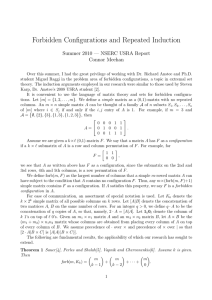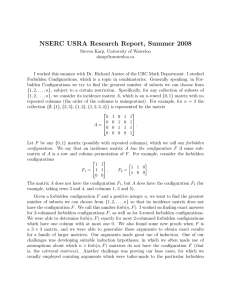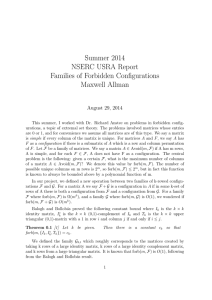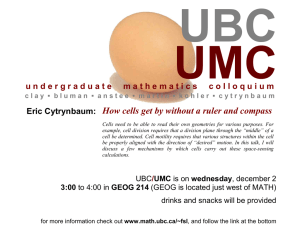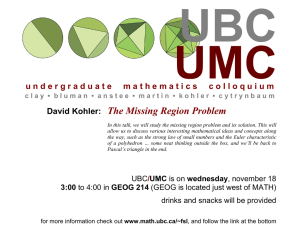Forbidden Configurations: A Survey
advertisement
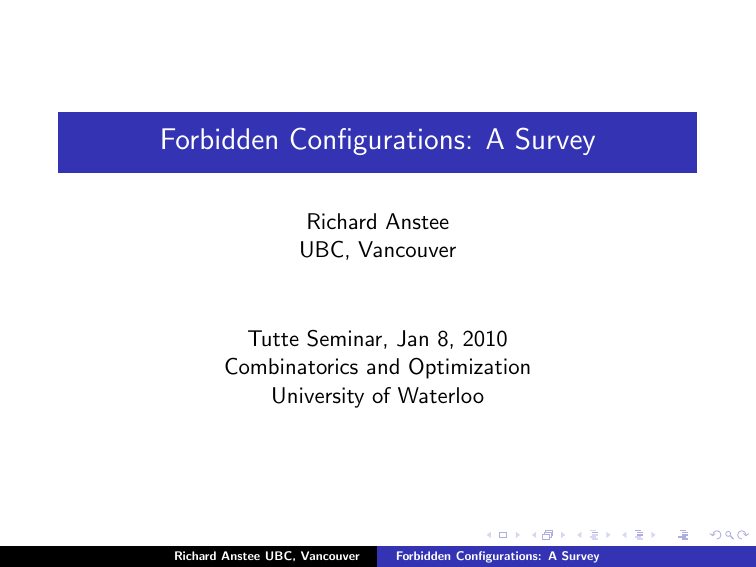
Forbidden Configurations: A Survey
Richard Anstee
UBC, Vancouver
Tutte Seminar, Jan 8, 2010
Combinatorics and Optimization
University of Waterloo
Richard Anstee UBC, Vancouver
Forbidden Configurations: A Survey
Introduction
Forbidden configurations are first described as a problem area in a
1985 paper. My subsequent work has involved a number of
coauthors: Farzin Barekat, Laura Dunwoody, Ron Ferguson, Balin
Fleming, Zoltan Füredi, Jerry Griggs, Nima Kamoosi, Steven Karp,
Peter Keevash, Miguel Raggi and Attila Sali but there are works of
other authors (some much older, some recent) impinging on this
problem as well (e.g. Balachandran, Dukes). For example, the
definition of VC -dimension uses a forbidden configuration. The
notion of trace is the set theory name for a configuration.
Survey at www.math.ubc.ca/∼anstee
Richard Anstee UBC, Vancouver
Forbidden Configurations: A Survey
Definition We say that a matrix A is simple if it is a (0,1)-matrix
with no repeated columns.
Richard Anstee UBC, Vancouver
Forbidden Configurations: A Survey
Definition We say that a matrix A is simple if it is a (0,1)-matrix
with no repeated columns.
i.e. if A is m-rowed then A is the incidence matrix of some family
A of subsets of [m] = {1, 2, . . . , m}.
0 0 0 1 1
A= 0 1 0 0 1
0 0 1 1 1
A = ∅, {2}, {3}, {1, 3}, {1, 2, 3}
Richard Anstee UBC, Vancouver
Forbidden Configurations: A Survey
Definition Given a matrix F , we say that A has F as a
configuration if there is a submatrix of A which is a row and
column permutation of F .
1 1 1 1 1 1
0 1 0 1 1 0
0 0 1 1
∈
F =
0 0 0 0 1 1 =A
0 1 0 1
0 1 1 0 0 0
Richard Anstee UBC, Vancouver
Forbidden Configurations: A Survey
Definition Given a matrix F , we say that A has F as a
configuration if there is a submatrix of A which is a row and
column permutation of F .
1 1 1 1 1 1
0 1 0 1 1 0
0 0 1 1
∈
F =
0 0 0 0 1 1 =A
0 1 0 1
0 1 1 0 0 0
We consider the property of forbidding a configuration F in A for
which we say F is a forbidden configuration in A.
Definition Let forb(m, F ) be the largest function of m and F so
that there exist a m × forb(m, F ) simple matrix with no
configuration F . Thus if A is any m × (forb(m, F ) + 1) simple
matrix then A contains F as a configuration.
Richard Anstee UBC, Vancouver
Forbidden Configurations: A Survey
Definition Given a matrix F , we say that A has F as a
configuration if there is a submatrix of A which is a row and
column permutation of F .
1 1 1 1 1 1
0 1 0 1 1 0
0 0 1 1
∈
F =
0 0 0 0 1 1 =A
0 1 0 1
0 1 1 0 0 0
We consider the property of forbidding a configuration F in A for
which we say F is a forbidden configuration in A.
Definition Let forb(m, F ) be the largest function of m and F so
that there exist a m × forb(m, F ) simple matrix with no
configuration F . Thus if A is any m × (forb(m, F ) + 1) simple
matrix then A contains F as a configuration.
1 0
For example, forb(m,
)=m+1
0 1
1 1
forb(m,
) = m + 2.
0 0
Richard Anstee UBC, Vancouver
Forbidden Configurations: A Survey
Definition Let Kk denote the k × 2k simple matrix of all possible
columns on k rows.
Theorem (Sauer 72, Perles and Shelah 72, Vapnik and
Chervonenkis 71)
m
m
m
= Θ(mk−1 )
+ ··· +
+
forb(m, Kk ) =
0
k −2
k −1
Richard Anstee UBC, Vancouver
Forbidden Configurations: A Survey
Definition Let Kk denote the k × 2k simple matrix of all possible
columns on k rows.
Theorem (Sauer 72, Perles and Shelah 72, Vapnik and
Chervonenkis 71)
m
m
m
= Θ(mk−1 )
+ ··· +
+
forb(m, Kk ) =
0
k −2
k −1
Corollary Let F be a k × ` simple matrix. Then
forb(m, F ) = O(m k−1 )
Richard Anstee UBC, Vancouver
Forbidden Configurations: A Survey
Definition Let Kk denote the k × 2k simple matrix of all possible
columns on k rows.
Theorem (Sauer 72, Perles and Shelah 72, Vapnik and
Chervonenkis 71)
m
m
m
= Θ(mk−1 )
+ ··· +
+
forb(m, Kk ) =
0
k −2
k −1
Corollary Let F be a k × ` simple matrix. Then
forb(m, F ) = O(m k−1 )
Theorem (Füredi 83). Let F be a k × ` matrix. Then
forb(m, F ) = O(m k )
Richard Anstee UBC, Vancouver
Forbidden Configurations: A Survey
Two interesting examples
Let
1 0 1 0
F 1 = 0 1 1 1 ,
0 0 0 1
forb(m, F1 ) = 2m,
1 0 1 0
F2 = 0 1 0 1
0 0 1 1
2
m
forb(m, F2 ) =
+m+1
4
Richard Anstee UBC, Vancouver
Forbidden Configurations: A Survey
Two interesting examples
Let
1 0 1 0
F 1 = 0 1 1 1 ,
0 0 0 1
forb(m, F1 ) = 2m,
1 0 1 0
F2 = 0 1 0 1
0 0 1 1
2
m
forb(m, F2 ) =
+m+1
4
Problem What drives the asymptotics of forb(m, F )? What
structures in F are important?
Richard Anstee UBC, Vancouver
Forbidden Configurations: A Survey
A Product Construction
The building blocks of our product constructions are I , I c and
1 1 1
0 1 1 1
1 0 0 0
0 1 0 0
1
0
1
1
c
0 1 1
I4 =
0 0 1 0 , I 4 = 1 1 0 1 , T 4 = 0 0 1
0 0 0
1 1 1 0
0 0 0 1
Note that
1
∈
/ I,
1
0
∈
/ Ic,
0
1 0
∈
/T
0 1
Richard Anstee UBC, Vancouver
Forbidden Configurations: A Survey
T:
1
1
1
1
A Product Construction
The building blocks of our product constructions are I , I c and
1 1 1
0 1 1 1
1 0 0 0
0 1 0 0
1
0
1
1
c
0 1 1
I4 =
0 0 1 0 , I 4 = 1 1 0 1 , T 4 = 0 0 1
0 0 0
1 1 1 0
0 0 0 1
Note that
1
∈
/ I,
1
T:
1
1
1
1
0
1 0
c
∈
/I ,
∈
/T
0
0 1
1 0
0
1
)=m+1
) = forb(m,
) = forb(m,
Note that forb(m,
0 1
0
1
Richard Anstee UBC, Vancouver
Forbidden Configurations: A Survey
Definition Given an m1 × n1 matrix A and a m2 × n2 matrix B we
define the product A × B as the (m1 + m2 ) × (n1 n2 ) matrix
consisting of all n1 n2 possible columns formed from placing a
column of A on top of a column of B. If A, B are simple, then
A × B is simple. (A, Griggs, Sali 97)
1 1 1 0 0 0 0 0 0
0 0 0 1 1 1 0 0 0
1 0 0
1 1 1
0 0 0 0 0 0 1 1 1
0 1 0 × 0 1 1 =
1 1 1 1 1 1 1 1 1
0 0 1
0 0 1
0 1 1 0 1 1 0 1 1
0 0 1 0 0 1 0 0 1
Given p simple matrices A1 , A2 , . . . , Ap , each of size m/p × m/p,
the p-fold product A1 × A2 × · · · × Ap is a simple matrix of size
m × (mp /p p ) i.e. Θ(m p ) columns.
Richard Anstee UBC, Vancouver
Forbidden Configurations: A Survey
Definition Given an m1 × n1 matrix A and a m2 × n2 matrix B we
define the product A × B as the (m1 + m2 ) × (n1 n2 ) matrix
consisting of all n1 n2 possible columns formed from placing a
column of A on top of a column of B. If A, B are simple, then
A × B is simple. (A, Griggs, Sali 97)
1 1 1 0 0 0 0 0 0
0 0 0 1 1 1 0 0 0
1 0 0
1 1 1
0 0 0 0 0 0 1 1 1
0 1 0 × 0 1 1 =
1 1 1 1 1 1 1 1 1
0 0 1
0 0 1
0 1 1 0 1 1 0 1 1
0 0 1 0 0 1 0 0 1
Given p simple matrices A1 , A2 , . . . , Ap , each of size m/p × m/p,
the p-fold product A1 × A2 × · · · × Ap is a simple matrix of size
m × (mp /p p ) i.e. Θ(m p ) columns.
Richard Anstee UBC, Vancouver
Forbidden Configurations: A Survey
The Conjecture
Definition Let x(F ) denote the largest p such that there is a
p-fold product which does not contain F as a configuration where
the p-fold product is A1 × A2 × · · · × Ap where each
c ,T
Ai ∈ {Im/p , Im/p
m/p }.
Richard Anstee UBC, Vancouver
Forbidden Configurations: A Survey
The Conjecture
Definition Let x(F ) denote the largest p such that there is a
p-fold product which does not contain F as a configuration where
the p-fold product is A1 × A2 × · · · × Ap where each
c ,T
Ai ∈ {Im/p , Im/p
m/p }.
Conjecture (A, Sali 05) forb(m, F ) is Θ(m x(F ) ).
In other words, our product constructions with the three building
blocks {I , I c , T } determine the asymptotically best constructions.
Richard Anstee UBC, Vancouver
Forbidden Configurations: A Survey
The Conjecture
Definition Let x(F ) denote the largest p such that there is a
p-fold product which does not contain F as a configuration where
the p-fold product is A1 × A2 × · · · × Ap where each
c ,T
Ai ∈ {Im/p , Im/p
m/p }.
Conjecture (A, Sali 05) forb(m, F ) is Θ(m x(F ) ).
In other words, our product constructions with the three building
blocks {I , I c , T } determine the asymptotically best constructions.
The conjecture has been verified for k × ` F where k = 2 (A,
Griggs, Sali 97) and k = 3 (A, Sali 05) and l = 2 (A, Keevash 06)
and for k-rowed F with bounds Θ(m k−1 ) or Θ(mk ) plus other
cases.
Richard Anstee UBC, Vancouver
Forbidden Configurations: A Survey
Refinements of the Sauer Bound
Theorem (Sauer 72, Perles and Shelah 72, Vapnik and
Chervonenkis 71)
forb(m, Kk ) is Θ(mk−1 )
1 0
0
1
.
, E3 =
, E2 =
Let E1 =
0 1
0
1
Theorem (A, Fleming) Let F be a k × l simple matrix such that
there is a pair of rows with no configuration E 1 and there is a pair
of rows with no configuration E2 and there is a pair of rows with
no configuration E3 . Then forb(m, F ) is O(m k−2 ).
Richard Anstee UBC, Vancouver
Forbidden Configurations: A Survey
Refinements of the Sauer Bound
Theorem (Sauer 72, Perles and Shelah 72, Vapnik and
Chervonenkis 71)
forb(m, Kk ) is Θ(mk−1 )
1 0
0
1
.
, E3 =
, E2 =
Let E1 =
0 1
0
1
Theorem (A, Fleming) Let F be a k × l simple matrix such that
there is a pair of rows with no configuration E 1 and there is a pair
of rows with no configuration E2 and there is a pair of rows with
no configuration E3 . Then forb(m, F ) is O(m k−2 ).
1 0 1 0
Note that F1 = 0 1 1 1
has no E1 on rows 1,3, no E2
0 0 0 1
on rows 1,2 and no E3 on rows 2,3. Thus forb(m, F1 ) is O(m).
Richard Anstee UBC, Vancouver
Forbidden Configurations: A Survey
1 0
0
1
.
, E3 =
, E2 =
Definition E1 =
0 1
0
1
Theorem (A, Fleming) Let E be given with E ∈ {E 1 , E2 , E3 }. Let
F be a k × l simple matrix with the property that every pair of
rows contains the configuration E . Then forb(m, F ) = Θ(m k−1 ).
1 0 1 0
F2 = 0 1 0 1 has E3 on rows 1,2.
0 0 1 1
Note that F2 has E3 on every pair of rows hence forb(m, F 2 ) is
Θ(m2 ) (A, Griggs, Sali 97).
In particular, this means F2 ∈
/ T × T which is the construction to
achieve the bound.
Richard Anstee UBC, Vancouver
Forbidden Configurations: A Survey
1 0
0
1
.
, E3 =
, E2 =
Definition E1 =
0 1
0
1
Theorem (A, Fleming) Let E be given with E ∈ {E 1 , E2 , E3 }. Let
F be a k × l simple matrix with the property that every pair of
rows contains the configuration E . Then forb(m, F ) = Θ(m k−1 ).
1 0 1 0
F2 = 0 1 0 1 has E3 on rows 2,3.
0 0 1 1
Note that F2 has E3 on every pair of rows hence forb(m, F 2 ) is
Θ(m2 ) (A, Griggs, Sali 97).
In particular, this means F2 ∈
/ T × T which is the construction to
achieve the bound.
Richard Anstee UBC, Vancouver
Forbidden Configurations: A Survey
1 0
0
1
.
, E3 =
, E2 =
Definition E1 =
0 1
0
1
Theorem (A, Fleming) Let E be given with E ∈ {E 1 , E2 , E3 }. Let
F be a k × l simple matrix with the property that every pair of
rows contains the configuration E . Then forb(m, F ) = Θ(m k−1 ).
1 0 1 0
F2 = 0 1 0 1 has E3 on rows 1,3.
0 0 1 1
Richard Anstee UBC, Vancouver
Forbidden Configurations: A Survey
1 0
0
1
.
, E3 =
, E2 =
Definition E1 =
0 1
0
1
Theorem (A, Fleming) Let E be given with E ∈ {E 1 , E2 , E3 }. Let
F be a k × l simple matrix with the property that every pair of
rows contains the configuration E . Then forb(m, F ) = Θ(m k−1 ).
1 0 1 0
F2 = 0 1 0 1 has E3 on rows 1,3.
0 0 1 1
Note that F2 has E3 on every pair of rows hence forb(m, F 2 ) is
Θ(m2 ) (A, Griggs, Sali 97).
In particular, this means F2 ∈
/ T × T which is the construction to
achieve the bound.
Richard Anstee UBC, Vancouver
Forbidden Configurations: A Survey
Definition Let t · M be the matrix [M M · · · M] consisting of t
copies of M placed side by side.
Theorem (A, Füredi 86) Let k, t be given.
m
m
t −2 m
m
+ ···
+
+
forb(m, t · Kk ) ≤
0
k −1
k
k +1 k
with equality if a certain k-design exists
Definition Let 1k 0` denote the vector of k 1’s on top of ` 0’s and
let 1k be the vector of k 1’s.
Theorem (A, Füredi 86) Let k, t be given.
forb(m, t · Kk ) = forb(m, t · 1k )
Richard Anstee UBC, Vancouver
Forbidden Configurations: A Survey
In order for a 4-rowed F to have forb(m, F ) be quadratic in m, we
must have the associated simple matrix have a quadratic bound.
There are three simple column-maximal 4-rowed F for which
forb(m, F ) is quadratic. Here is one example:
1 0 1 0 1 0
0 1 0 1 0 1
F3 =
0 0 1 1 1 1
0 0 1 1 0 0
How can we repeat columns in F3 and still have a quadratic
bound? We note that forb(m, 2 · 11 03 ) and forb(m, 2 · 13 01 ) are
both cubic and so we only consider taking multiple copies of the
columns of sum 2.
Richard Anstee UBC, Vancouver
Forbidden Configurations: A Survey
In order for a 4-rowed F to have forb(m, F ) be quadratic in m, we
must have the associated simple matrix have a quadratic bound.
There are three simple column-maximal 4-rowed F for which
forb(m, F ) is quadratic. Here is one example:
1 0 1 0 1 0
0 1 0 1 0 1
F3 =
0 0 1 1 1 1
0 0 1 1 0 0
How can we repeat columns in F3 and still have a quadratic
bound? We note that forb(m, 2 · 11 03 ) and forb(m, 2 · 13 01 ) are
both cubic and so we only consider taking multiple copies of the
columns of sum 2. For a fixed t, let
1 0 1 0
1 0
0 1 0 1 0 1
F3 (t) =
0 0 1 1 t · 1 1
0 0 1 1
0 0
Richard Anstee UBC, Vancouver
Forbidden Configurations: A Survey
1
0
F3 (t) =
0
0
0
1
0
0
1
0
1
1
1
0
1 0
t·
1 1
0
1
0
1
1
0
Theorem (A, Raggi, Sali 09) Let t be given. Then forb(m, F 3 (t))
is O(m2 ).
Note that F3 = F3 (1). The proof is currently a rather complicated
induction.
Richard Anstee UBC, Vancouver
Forbidden Configurations: A Survey
1
0
F3 (t) =
0
0
0
1
0
0
1
0
1
1
1
0
1 0
t·
1 1
0
1
0
1
1
0
Theorem (A, Raggi, Sali 09) Let t be given. Then forb(m, F 3 (t))
is O(m2 ).
Note that F3 = F3 (1). The proof is currently a rather complicated
induction.
There are six k-rowed F for each k ≥ 6 to consider in order to
establish the boundary between O(m k−2 ) and Ω(mk−1 ) (using the
predictions of the conjecture) and there are only three 4-rowed F
to consider of which F3 (t) is one. The other two have not been
shown to have quadratic bounds.
Richard Anstee UBC, Vancouver
Forbidden Configurations: A Survey
Let
1
1
F4 (t) = t ·
0
0
0
0
1
1
Conjecture Let t be given. forb(m, F 4 (t)) is O(m 2 ).
Richard Anstee UBC, Vancouver
Forbidden Configurations: A Survey
Let
1
1
F4 (t) = t ·
0
0
0
0
1
1
Conjecture Let t be given. forb(m, F 4 (t)) is O(m 2 ).
This appears to be a pivotal case for 4-rowed F :
Theorem (A, Barekat, Sali 09)
m
+m−2
forb(m, F4 (1)) =
2
The above conjecture follows from the general conjecture and is
true for t = 2. Solving this would no doubt enable the proof of
quadratic bounds for the two other 4-rowed F
Richard Anstee UBC, Vancouver
Forbidden Configurations: A Survey
Boundary cases k-rowed F with bounds θ(m k−1)
Let B be a k × (k + 1) matrix which has one column of each
column sum. Given two matrices C , D, let C \D denote the matrix
obtained from C by deleting any columns of D that are in C (i.e.
set difference). Let
FB (t) = [Kk |t · [Kk \B]].
Theorem (A, Griggs, Sali 97, A, Sali 05,
A, Fleming, Füredi, Sali 05)
Let t, B be given. Then forb(m, FB (t)) is Θ(m k−1 ).
The difficult problem here was the bound although induction works.
Richard Anstee UBC, Vancouver
Forbidden Configurations: A Survey
Let D be the k × (2k − 2k−2 − 1) simple matrix with all columns
of sum at least 1 that do not simultaneously have 1’s in rows 1 and
2. We take FD (t) = [0k (t + 1) · D] which for k = 4 becomes
0 0 0 1 1 1 1 0 0 0 0
0
0 0 0 0 0 0 0 1 1 1 1
0
FD (t) =
0 (t + 1) · 1 0 1 0 1 0 1 0 1 0 1
0 1 1 0 0 1 1 0 0 1 1
0
Richard Anstee UBC, Vancouver
Forbidden Configurations: A Survey
Let D be the k × (2k − 2k−2 − 1) simple matrix with all columns
of sum at least 1 that do not simultaneously have 1’s in rows 1 and
2. We take FD (t) = [0k (t + 1) · D] which for k = 4 becomes
0 0 0 1 1 1 1 0 0 0 0
0
0 0 0 0 0 0 0 1 1 1 1
0
FD (t) =
0 (t + 1) · 1 0 1 0 1 0 1 0 1 0 1
0 1 1 0 0 1 1 0 0 1 1
0
Theorem (A, Sali 05 (for k = 3), A, Fleming 09)
Let t be given. Then forb(m, FD (t)) is Θ(m k−1 ).
The argument used standard results for directed graphs, indicator
polynomials and a linear algebra rank argument
Richard Anstee UBC, Vancouver
Forbidden Configurations: A Survey
Let D be the k × (2k − 2k−2 − 1) simple matrix with all columns
of sum at least 1 that do not simultaneously have 1’s in rows 1 and
2. We take FD (t) = [0k (t + 1) · D] which for k = 4 becomes
0 0 0 1 1 1 1 0 0 0 0
0
0 0 0 0 0 0 0 1 1 1 1
0
FD (t) =
0 (t + 1) · 1 0 1 0 1 0 1 0 1 0 1
0 1 1 0 0 1 1 0 0 1 1
0
Theorem (A, Sali 05 (for k = 3), A, Fleming 09)
Let t be given. Then forb(m, FD (t)) is Θ(m k−1 ).
The argument used standard results for directed graphs, indicator
polynomials and a linear algebra rank argument
Theorem Let k be given and assume F is a k-rowed configuration
which is not a configuration in FB (t) for any choice of B as a
k × (k + 1) simple matrix with one column of each column sum
and not in FD (t) or FD (t)c , for any t. Then forb(m, F ) is Θ(m k ).
Richard Anstee UBC, Vancouver
Forbidden Configurations: A Survey
Designs and Forbidden Configurations
A 2-design Sλ (2, 3, v ) consists of λ3 v2 triples from
[v ] = {1, 2, . . . , v } such that for each pair i, j ∈ [v2 ] , there are
exactly λ triples containing i, j. If we encode the triple system as a
v -rowed (0,1)-matrix A such that the columns are the incidence
vectors of the triples, then A has no 2 × (λ + 1) submatrix of 1’s.
Richard Anstee UBC, Vancouver
Forbidden Configurations: A Survey
Designs and Forbidden Configurations
A 2-design Sλ (2, 3, v ) consists of λ3 v2 triples from
[v ] = {1, 2, . . . , v } such that for each pair i, j ∈ [v2 ] , there are
exactly λ triples containing i, j. If we encode the triple system as a
v -rowed (0,1)-matrix A such that the columns are the incidence
vectors of the triples, then A has no 2 × (λ + 1) submatrix of 1’s.
Remark If A is a v × n (0,1)-matrix with column sums 3 and A
has no 2 × (λ + 1) submatrix of 1’s then n ≤ λ3 v2 with equality if
and only if the columns of A correspond to the triples of a 2-design
Sλ (2, 3, v ).
Richard Anstee UBC, Vancouver
Forbidden Configurations: A Survey
Theorem (A, Barekat) Let λ and v be given integers. There exists
an M so that for v > M, if A is an v × n (0,1)-matrix with column
sums in {3, 4, . . . , v − 1} and A has no 3 × (λ + 1) configuration
1 1 ··· 1
1 1 · · · 1
0 0 ··· 0
then
λ v
n≤
3 2
and we have equality if and only if the columns of A correspond to
the triples of a 2-design Sλ (2, 3, v ).
Richard Anstee UBC, Vancouver
Forbidden Configurations: A Survey
Theorem (A, Barekat) Let λ and v be given integers. There exists
an M so that for v > M, if A is an v × n (0,1)-matrix with column
sums in {3, 4, . . . , v − 3} and A has no 4 × (λ + 1) configuration
1 1 ··· 1
1 1 · · · 1
0 0 · · · 0
0 0 ··· 0
then
λ v
n≤
3 2
with equality onlyif there are positive integers a, b with a + b = λ
and there are 3a v2 columns of A of column sum 3 corresponding
to the triples of a 2-design Sa (2, 3, v ) and there are b3 v2 columns
of A of column sum v − 3 corresponding to (v − 3) - sets whose
complements (in [v ]) corresponding to the triples of a 2-design
Sb (2, 3, v ).
Richard Anstee UBC, Vancouver
Forbidden Configurations: A Survey
Theorem (N. Balachandran 09) Let λ and v be given integers.
There exists an M so that for v > M, if A is an v × n (0,1)-matrix
with column sums in {4, 5, . . . , v − 1} and A has no 4 × 2
configuration
1 1
1 1
1 1
0 0
then
1 v
n≤
4 3
with equality only if there is 3-design S 1 (3, 4, v ). The 14 v3
columns of A have column sum 4 and correspond to 4-sets of the
3-design S1 (3, 4, v ).
Naranjan Balachandran has indicated that he has made further
progress on this problem
Richard Anstee UBC, Vancouver
Forbidden Configurations: A Survey
k × 2 Forbidden Configurations
Let Fabcd
1
:
a
1
1
b
:
1
=
0
c :
0
0
d :
0
1
:
1
0
:
0
1
:
1
0
:
0
For the purposes of forbidden configurations we may assume that
a ≥ d and b ≥ c.
Richard Anstee UBC, Vancouver
Forbidden Configurations: A Survey
The following result used a difficult ‘stability’ result and the
resulting constants in the bounds were unrealistic but the
asymptotics are further evidence for the conjecture.
Theorem (A-Keevash 06) Assume a,b,c,d are given with a ≥ d
and b ≥ c. If b > c or a, b ≥ 1, then
forb(m, Fabcd ) = Θ(ma+b−1 ).
Also forb(m, F0bb0 ) = Θ(mb ) and forb(m, Fa00d ) = Θ(ma ).
Richard Anstee UBC, Vancouver
Forbidden Configurations: A Survey
It is convenient to define 1k 0` as the (k + `) × 1 column of k 1’s
on top of ` 0’s. Then the first column of F abcd is 1a+b 0c+d .
Theorem (A, Karp 09) Let a, b ≥ 2. Then
a+b−1
X X
m m
m
+
j
j
a+b−1
X j=0
X
m m
m
+
j
j
a+b−1
X m
X
m
m
+
j
j
forb(m, Fab01 ) = forb(m, 1a+b 01 ) =
j=0
forb(m, Fab10 ) = forb(m, 1a+b 01 ) =
forb(m, Fab11 ) = forb(m, 1a+b 02 ) =
j=0
Richard Anstee UBC, Vancouver
j=m
j=m
j=m−1
Forbidden Configurations: A Survey
Problem (A, Karp 09). Let a, b, c, d be given with a, b much
larger than c, d. Is it true that
forb(m, Fabcd ) = forb(m, 1a+b 0c+d )?
Richard Anstee UBC, Vancouver
Forbidden Configurations: A Survey
Problem (A, Karp 09). Let a, b, c, d be given with a, b much
larger than c, d. Is it true that
forb(m, Fabcd ) = forb(m, 1a+b 0c+d )?
We are asking when we can make the first column with a + b 1’s
and c + d 0’s dominate the bound.
Richard Anstee UBC, Vancouver
Forbidden Configurations: A Survey
F2110
1
1
=
1
0
1
1
0
1
Not all k × 2 cases are obvious:
Theorem Let c be a positive real number. Let A be an
m × c m2 + m + 2 simple
matrix with no F2110 . Then
for some
M
2
M > m, there is an M × (c + m(m−1) ) 2 + M + 2 simple
matrix with no F2110 .
Richard Anstee UBC, Vancouver
Forbidden Configurations: A Survey
Critical Substructures
Definition A critical substructure of a configuration F is a
minimal configuration F 0 contained in F such that
forb(m, F ) = forb(m, F 0 )
A critical substructure is what drives the construction yielding a
lower bound forb(m, F ) where some other argument provides the
upper bound for forb(m, F ).
A consequence is that for a configuration F 00 which contains F 0
and is contained in F , we deduce that
forb(m, F ) = forb(m, F 00 ) = forb(m, F 0 )
Richard Anstee UBC, Vancouver
Forbidden Configurations: A Survey
Critical Substructures for K3
1 1 1 0 1 0 0 0
K3 = 1 1 0 1 0 1 0 0
1 0 1 1 0 0 1 0
Critical substructures are 13 , K32 , K31 , 03 , 2 · 12 , 2 · 02 since
forb(m, 13 ) = forb(m, K31 ) = forb(m, K32 ) = forb(m, 03 )
= forb(m, 2 · 12 ) = forb(m, 2 · 02 ).
Richard Anstee UBC, Vancouver
Forbidden Configurations: A Survey
Critical Substructures for K3
1 1 1 0 1 0 0 0
K3 = 1 1 0 1 0 1 0 0
1 0 1 1 0 0 1 0
Critical substructures are 13 , K32 , K31 , 03 , 2 · 12 , 2 · 02 since
forb(m, 13 ) = forb(m, K31 ) = forb(m, K32 ) = forb(m, 03 )
= forb(m, 2 · 12 ) = forb(m, 2 · 02 ).
Richard Anstee UBC, Vancouver
Forbidden Configurations: A Survey
Critical Substructures for K3
1 1 1 0 1 0 0 0
K3 = 1 1 0 1 0 1 0 0
1 0 1 1 0 0 1 0
Critical substructures are 13 , K32 , K31 , 03 , 2 · 12 , 2 · 02 since
forb(m, 13 ) = forb(m, K31 ) = forb(m, K32 ) = forb(m, 03 )
= forb(m, 2 · 12 ) = forb(m, 2 · 02 ).
Richard Anstee UBC, Vancouver
Forbidden Configurations: A Survey
Critical Substructures for K3
1 1 1 0 1 0 0 0
K3 = 1 1 0 1 0 1 0 0
1 0 1 1 0 0 1 0
Critical substructures are 13 , K32 , K31 , 03 , 2 · 12 , 2 · 02 since
forb(m, 13 ) = forb(m, K31 ) = forb(m, K32 ) = forb(m, 03 )
= forb(m, 2 · 12 ) = forb(m, 2 · 02 ).
Richard Anstee UBC, Vancouver
Forbidden Configurations: A Survey
Critical Substructures for K3
1 1 1 0 1 0 0 0
K3 = 1 1 0 1 0 1 0 0
1 0 1 1 0 0 1 0
Critical substructures are 13 , K32 , K31 , 03 , 2 · 12 , 2 · 02 since
forb(m, 13 ) = forb(m, K31 ) = forb(m, K32 ) = forb(m, 03 )
= forb(m, 2 · 12 ) = forb(m, 2 · 02 ).
Richard Anstee UBC, Vancouver
Forbidden Configurations: A Survey
Critical Substructures for K3
1 1 1 0 1 0 0 0
K3 = 1 1 0 1 0 1 0 0
1 0 1 1 0 0 1 0
Critical substructures are 13 , K32 , K31 , 03 , 2 · 12 , 2 · 02 since
forb(m, 13 ) = forb(m, K31 ) = forb(m, K32 ) = forb(m, 03 )
= forb(m, 2 · 12 ) = forb(m, 2 · 02 ).
Richard Anstee UBC, Vancouver
Forbidden Configurations: A Survey
Critical Substructures for K3
1 1 1 0 1 0 0 0
K3 = 1 1 0 1 0 1 0 0
1 0 1 1 0 0 1 0
Critical substructures are 13 , K32 , K31 , 03 , 2 · 12 , 2 · 02 since
forb(m, 13 ) = forb(m, K31 ) = forb(m, K32 ) = forb(m, 03 )
= forb(m, 2 · 12 ) = forb(m, 2 · 02 ).
Richard Anstee UBC, Vancouver
Forbidden Configurations: A Survey
Another Example of Critical Substructures
1
1
F5 =
1
0
1
1
0
0
1
0
1
0
1
0
0
0
Theorem (A, Karp 09) For m ≥ 3 we have
m
forb(m, F5 ) = forb(m, 2 · 12 01 ) = forb(m, 2 · 11 02 ) =
+ m + 2.
2
Thus for
1 1 1 1
F6 = 1 1 0 0
0 0 0 0
we deduce that forb(m, F6 ) = forb(m, F5 ) = forb(m, 2 · 12 01 )
= forb(m, 2 · 11 02 ).
Richard Anstee UBC, Vancouver
Forbidden Configurations: A Survey
Another Example of Critical Substructures
1
1
F5 =
1
0
1
1
0
0
1
0
1
0
1
0
0
0
Theorem (A, Karp 09) For m ≥ 3 we have
m
forb(m, F5 ) = forb(m, 2 · 12 01 ) = forb(m, 2 · 11 02 ) =
+ m + 2.
2
Thus for
1 1 1 1
F6 = 1 1 0 0
0 0 0 0
we deduce that forb(m, F6 ) = forb(m, F5 ) = forb(m, 2 · 12 01 )
= forb(m, 2 · 11 02 ).
Richard Anstee UBC, Vancouver
Forbidden Configurations: A Survey
Another Example of Critical Substructures
1
1
F5 =
1
0
1
1
0
0
1
0
1
0
1
0
0
0
Theorem (A, Karp 09) For m ≥ 3 we have
m
forb(m, F5 ) = forb(m, 2 · 12 01 ) = forb(m, 2 · 11 02 ) =
+ m + 2.
2
Thus for
1 1 1 1
F6 = 1 1 0 0
0 0 0 0
we deduce that forb(m, F6 ) = forb(m, F5 ) = forb(m, 2 · 12 01 )
= forb(m, 2 · 11 02 ).
Richard Anstee UBC, Vancouver
Forbidden Configurations: A Survey
Exact Bounds
1 1 1
F7 = 1 1 1
1 0 0
Theorem (A,Karp 09)
4 m
+m+1
forb(m, F7 ) = forb(m, 3 · 12 ) ≤
3 2
with equality for m ≡ 1, 3(mod 6).
Richard Anstee UBC, Vancouver
Forbidden Configurations: A Survey
Exact Bounds
1 1 1
F7 = 1 1 1
1 0 0
Theorem (A,Karp 09)
4 m
+m+1
forb(m, F7 ) = forb(m, 3 · 12 ) ≤
3 2
with equality for m ≡ 1, 3(mod 6).
Richard Anstee UBC, Vancouver
Forbidden Configurations: A Survey
THANKS! ITS FUN TO VISIT WATERLOO AGAIN!
Richard Anstee UBC, Vancouver
Forbidden Configurations: A Survey
Definition We say F ⊆ 2[m] is t-intersecting if for every pair
A, B ∈ F, we have |A ∩ B| ≥ t.
Theorem (Ahlswede and Khachatrian 97)
Complete Intersection Theorem.
Let k, r be given. A maximum sized (k - r )-intersecting k-uniform
is isomorphic to Ir1 ,r2 for some choice r1 + r2 = r
family F ⊆ [m]
k
and for some choice G ⊆ [m] where |G | = k − r 1 + r2 where
: |A ∩ G | ≥ k − r1 }
Ir1 ,r2 = {A ⊆ [m]
k
This generalizes the Erdős-Ko-Rado Theorem (61).
Richard Anstee UBC, Vancouver
Forbidden Configurations: A Survey
Theorem (A-Keevash 06) Stability Lemma.
Let F ⊆ [m]
k . Assume that F is (k - r )-intersecting and
|F| ≥ (6r )5r +7 mr −1 .
Then F ⊆ Ir1 ,r2 for some choice r1 + r2 = r and for some choice
G ⊆ [m] where |G | = k − r1 + r2 .
This result is for large intersections; we use it with a fixed r where
k can grow with m.
Richard Anstee UBC, Vancouver
Forbidden Configurations: A Survey
Definition Let Fa,b,c,d denote the (a + b + c + d) × 2 matrix of a
rows [11], b rows of [10], c rows of [01], and d rows of [00]. We
assume a ≥ d and b ≥ c.
Theorem (A-Keevash 06) if b > c or a, b ≥ 1, then
forb(m, Fa,b,c,d ) = Θ(ma+b−1 ).
Also forb(m, F0,b,b,0 ) = Θ(mb ) and forb(m, Fa,0,0,d ) = Θ(ma ).
Richard Anstee UBC, Vancouver
Forbidden Configurations: A Survey
Definition Let Fa,b,c,d denote the (a + b + c + d) × 2 matrix of a
rows [11], b rows of [10], c rows of [01], and d rows of [00]. We
assume a ≥ d and b ≥ c.
Theorem (A-Keevash 06) if b > c or a, b ≥ 1, then
forb(m, Fa,b,c,d ) = Θ(ma+b−1 ).
Also forb(m, F0,b,b,0 ) = Θ(mb ) and forb(m, Fa,0,0,d ) = Θ(ma ).
Proof: The conjecture yields constructions. The proofs of the
bounds make heavy use of the stability lemma in conjunction with
induction.
Richard Anstee UBC, Vancouver
Forbidden Configurations: A Survey
Definition Let Fa,b,c,d denote the (a + b + c + d) × 2 matrix of a
rows [11], b rows of [10], c rows of [01], and d rows of [00]. We
assume a ≥ d and b ≥ c.
Theorem (A-Keevash 06) if b > c or a, b ≥ 1, then
forb(m, Fa,b,c,d ) = Θ(ma+b−1 ).
Also forb(m, F0,b,b,0 ) = Θ(mb ) and forb(m, Fa,0,0,d ) = Θ(ma ).
Proof: The conjecture yields constructions. The proofs of the
bounds make heavy use of the stability lemma in conjunction with
induction.
The theorem is further evidence for the conjecture.
Richard Anstee UBC, Vancouver
Forbidden Configurations: A Survey
e.g. Let A be a simple matrix with no F 0,3,2,0
1
1
=
1
0
0
0
0
0
1
1
00 ··· 0 11 ··· 1
(the standard induction),
Let A =
B1 B2 B2 B3
where B2 is chosen to be all columns which are repeated after
deleting row 1 of A.
Then [B1 B2 B3 ] is simple and has no F0,3,2,0 and so by induction
has at most c(m − 1)2 columns. B2 is also simple and we verify
that B2 has at most cm columns and so by induction
forb(m, F0,3,2,0 ) ≤ c(m − 1)2 + cm ≤ cm2 .
Richard Anstee UBC, Vancouver
Forbidden Configurations: A Survey
1 0
1 0
00 ··· 0 11 ··· 1
1
0
with no F0,3,2,0 =
Given A =
B1 B2 B2 B3
0 1
0 1
1 0
1 0
1 0
1 0
then B2 has no F0,2,2,0 =
0 1 or F0,3,1,0 = 1 0
0 1
0 1
Our proof then uses the fact that if we only consider the columns
of column sum k in B2 as a set system, then using the fact that
F0,2,2,0 is forbidden we deduce that the k-uniform set system is
(k - 1)-intersecting. We then use our stability result to either
determine the columns have a certain structure or that the bound
is true because there are so few columns.
Richard Anstee UBC, Vancouver
Forbidden Configurations: A Survey
